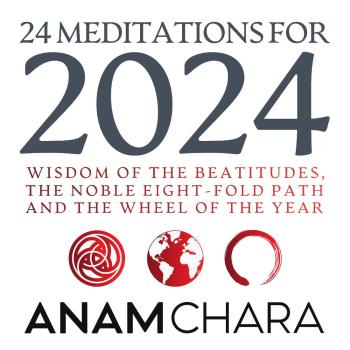 So you’ve been to a centering prayer workshop or two, and now you participate in a weekly centering prayer group. You are committed to praying silently twice a day — at least most days. You go on retreat at a monastery or retreat center once or twice a year, and you meet with a spiritual director regularly. Contemplation has become a meaningful, sustainable part of your life.
So you’ve been to a centering prayer workshop or two, and now you participate in a weekly centering prayer group. You are committed to praying silently twice a day — at least most days. You go on retreat at a monastery or retreat center once or twice a year, and you meet with a spiritual director regularly. Contemplation has become a meaningful, sustainable part of your life.
Now what?
(Okay, I know many people are not there yet. And if you’re like me, even if you’ve been doing this for a while, you may feel your prayer is not nearly as disciplined or consistent as you would like it to be. But even if your relationship with contemplative prayer is haphazard and tenuous, the question still stands. What is the long term consequences of all this silent prayer business?)
My experience is that prayer changes things — but the “things” that prayer changes are mostly within me. I don’t pray to change God (as if), but rather to open my heart to allow the Spirit to change me. Even when I pray for some material good — like asking for a loved one to overcome an illness — the subtext of such a prayer is always “your will be done, God — and give me the grace to live according to your will.”
How, then, does silent prayer — prayer without words — result in change, even interior change? To answer this question requires faith — faith that the Holy Spirit works in our hearts at a level deeper than words (see Romans 8:26). We enter into silence as a way of praying because we believe that words cannot fully capture the depth of communication that we wish to lovingly offer God — or that God wishes to lovingly offer us. Silence is necessary because words sometimes get in the way.
But back to our question. What happens after we persevere in silent prayer for a season — or a lifetime?
Every human being is different and so is every life circumstance, so there is no one-size-fits-all roadmap of how silent prayer helps us to nurture a contemplative life. Nevertheless, I believe, based on my own life experience, the testimony of friends, and the wisdom of the great mystics, that a life which includes regular and sustained silent prayer — imperfect though it may be — can begin to yield spiritual fruit like the following.
Silence teaches us to have a mature faith — a faith grounded in mystery rather than in certainty. Every Sunday millions of Christians world wide recite the Creed, which begins (depending on the version) either with “I believe” or “We believe.” These words of faith matter to us because they shape us, they form us as followers of Christ and members of Christ’s body, the Church. But there is a point where words simply fail us. Faith is not the same thing as scientific proof — at the heart of faith necessarily we find mystery, a realm that cannot be rationally understood. It can only be intuitively embraced. Any God that could be comprehended by a finite human brain is a god too small to worship. Silence invites us to let go of the mind’s insistence on certainly, and instead enter into the heart’s openness to mystery: where love is the north star.
Silence invites us to be better listeners, and therefore, more compassionate. The Rule of Saint Benedict begins with that powerful word: Listen. Just watch the news on Fox or CNN and it becomes painfully obvious that we don’t know how to listen very well: we keep shouting over each other, especially when we disagree or feel something important is at stake. Contemplation subverts the willfulness of the egoic mind: when I listen, I am not invested in proving myself right, but rather in fostering a relationship with whoever it is I’m listening to. Compassion is the natural fruit of a heart-centered, rather than willfulness-centered, approach to life.
Silence calls us into a new, and more expansive, relationship with time. In silence there is no hurry. Anyone who has much experience with contemplative silent prayer sooner or later has the experience that the perception of time can be altered radically in silence. Sometimes it seems like the clock speeds up; other times it seems to slow way down. Clock-time, of course, remains consistent, but our perception of time determines whether we see time as a friend or a foe. In silence we learn to hold our perception of time as lightly as we hold any other thoughts, feelings, or perceptions. The end result: an increasing willingness to fully inhabit the present moment, neither worrying about the future nor regretting the past. In other words, we more fully inhabit our lives — which frees us to love, be loved, and find joy.
Silence gently encourages us to become less attached to our thoughts, our perspective, and indeed our very egos. Some contemplative writers talk a lot about the “false self” — I don’t particularly care for that terminol0gy because it strikes me as dualistic. Rather than judging our experience of the self as “true” or “false” I think it’s more useful to simply acknowledge that sometimes we become more enmeshed in blaming, judging, defending, and comparing, and other times less so. Silence helps us to find our way to that less-enmeshed place.
Silence gives us the spiritual nutrients necessary to foster a new way of seeing. Silence may be most intimately associated with the sense of hearing, but I believe it also teaches us to see differently as well, what Richard Rohr calls in his book The Naked Now “learning to see as the mystics seee.” How do the mystics see? With affirmation rather than condemnation, with discernment rather than judgment, with compassion rather than blame. Learning to see how the mystics see — which is to say, to see with the eyes of Love — is a lifelong process, and it comes in fits and starts with plenty of two-steps-forward-one-step-back moments. But perseverance in silence helps us along the path, slowly but compassionately.
The late Eugene Peterson wrote a book about contemplative discipleship with an evocative title: A Long Obedience in the Same Direction. Remember, spiritually speaking obedience means listening (to God) more than mere compliance. But the point is, this deep-listening which forms us into restoring the image and likeness of God in our lives is not a quick process, but rather a slow re-formation of the heart. Silence invites us to be patient in this long slow process. It helps us to recognize that the long journey is worth taking.
Enjoy reading this blog?
Click here to become a patron.














